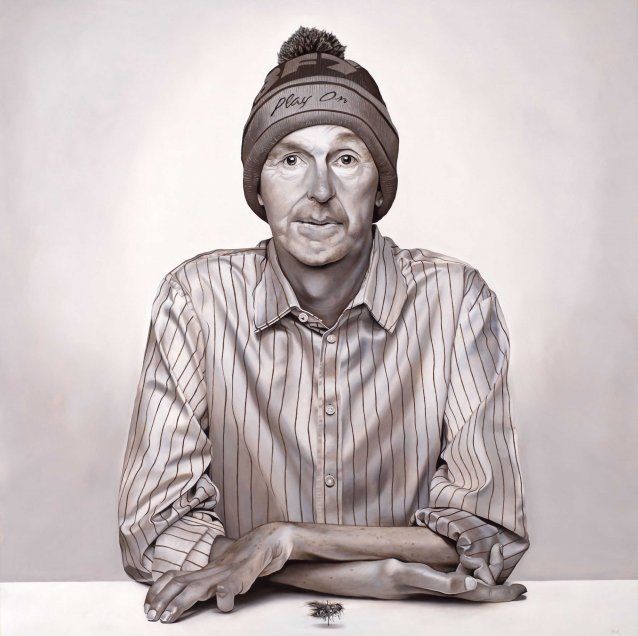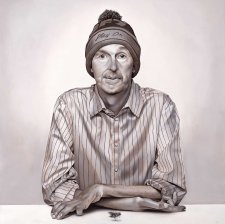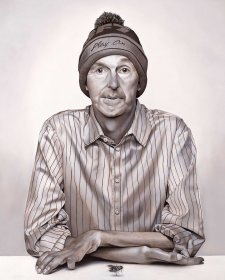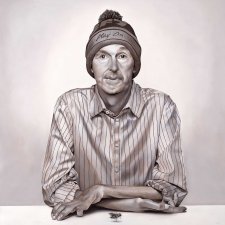- Neale's a Melbourne icon. I guess his career in football was legendary. And then, I guess the things he's done for the research and raising funds to fight motor neurone disease has been incredible. I think he took his profile and used that as a way to be able to do something really, really outstanding. Normally, if I'm painting a portrait, normally I meet and have a conversation and sort of think about that conversation and try and research the person a little bit before I try to really settle with what the concept's gonna be. When I first met Neale, I was able to go to his house and meet with his wife, Jan, and himself. He refers to motor neurone disease as the beast. You know, he refers to it as this ugly, terrible thing. You know, I think he, the way he explains it, it's halfway between a blowfly and a moth, and he said that that's the ugliest thing that he can possibly think of. I thought the idea of actually trying to portray that through trying to create visually what that looked like would be an important part of the painting. At the start, I said, "Do you want your arms to be in the painting?" And he said they have to be in the painting because they show the disease. In the image, he's sitting with his arms crossed in front of him, and for him to have his arms like that, Jan would put them up onto the plinth that we had in front of him. Yeah, he really wanted that because this painting had to be about his fight with motor neurone disease. And, although his arms are like that, he wanted them there, but he wanted to really be able to sit upright, look directly at the camera. And there's a really, something about his focus in the painting in those initial photographs was just dead on. It was sort of like, I'm gonna take this on. And yeah, I thought that was quite powerful. I've always made art. My mum always had art materials around the house. She'd go off and do art classes and bring home these, you know, the life drawings and the still lifes, and things that she was working on, and because the materials were there, and I'd always look at it and go, oh, I love that paper. I love that, you know, the chalk or the charcoal that she's working with, and I'd sort of just pick them up and start drawing. But no one ever sort of said, oh, you should do this. It was just something that I did. And I would sit there and I'd draw for hours and just love it. And that love of art has just always continued from an early age, you know, to now. It's gonna be there for the rest of my life, I think. I always wanna make sure that the sitter, it's gonna be an accurate depiction of who they are, and that I'm not saying something that's not true. And then, normally, I would work out, like, we'd do a photo shoot. I'd work from a series of images and actually create kind of like an aggregate of those images. I work from that, and then once I'm happy with that image, when it starts to feel right, that's when I start painting, and I go from that image. And I normally, I stick pretty closely to what that image is. And then, as I'm going, I might fine tune in the paint, you know, the contrast between light and dark or whether something needs to have less detail or more detail, you know. A lot of that comes out in the paints. I mean, my paintings end up looking a lot like photographs, but they need to be a heightened version of that. They can't just be a photograph. And also that's to do with my relationship with the painting. I need to be making decisions as I go so that I can love that process of paint. I've been interested in realism for forever. I mean, I wouldn't know to call it that when I was a kid, but, you know, the idea of taking something and trying to focus on the detail and pull things out, which make it, you know, which start to make the painting really, or the drawing, really stand out has always been something that I've loved. You know, when I was a kid, I used to draw the mountains and draw things from postcards or find things in the "National Geographic" and draw them. And then, as I started to realise that, you know, the images in the artworks can start to convey meaning, and you can tell the story and the narrative, I guess I started to really think about what I was putting into the images, how I would juxtapose one thing against another and it could start to tell a story. And also, that viewers could interpret those images in different ways, whether it was a way that I wanted them to read it, or whether it was a way that they could interpret it. So I always thought if someone can interpret an image differently than the way that I intend it to be, I always think that's a really nice thing to happen.














